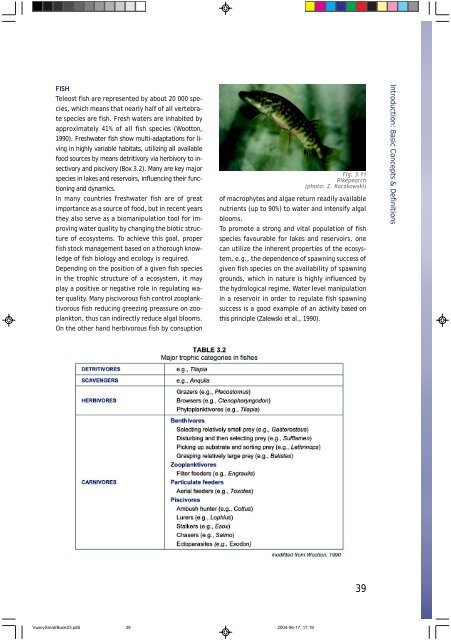Manual - International Environmental Technology Centre
Manual - International Environmental Technology Centre
Manual - International Environmental Technology Centre
You also want an ePaper? Increase the reach of your titles
YUMPU automatically turns print PDFs into web optimized ePapers that Google loves.
FISH<br />
Teleost fish are represented by about 20 000 species,<br />
which means that nearly half of all vertebrate<br />
species are fish. Fresh waters are inhabited by<br />
approximately 41% of all fish species (Wootton,<br />
1990). Freshwater fish show multi-adaptations for living<br />
in highly variable habitats, utilizing all available<br />
food sources by means detritivory via herbivory to insectivory<br />
and piscivory (Box 3.2). Many are key major<br />
species in lakes and reservoirs, influencing their functioning<br />
and dynamics.<br />
In many countries freshwater fish are of great<br />
importance as a source of food, but in recent years<br />
they also serve as a biomanipulation tool for improving<br />
water quality by changing the biotic structure<br />
of ecosystems. To achieve this goal, proper<br />
fish stock management based on a thorough knowledge<br />
of fish biology and ecology is required.<br />
Depending on the position of a given fish species<br />
in the trophic structure of a ecosystem, it may<br />
play a positive or negative role in regulating water<br />
quality. Many piscivorous fish control zooplanktivorous<br />
fish reducing greezing preassure on zooplankton,<br />
thus can indirectly reduce algal blooms.<br />
On the other hand herbivorous fish by consuption<br />
of macrophytes and algae return readily available<br />
nutrients (up to 90%) to water and intensify algal<br />
blooms.<br />
To promote a strong and vital population of fish<br />
species favourable for lakes and reservoirs, one<br />
can utilize the inherent properties of the ecosystem,<br />
e.g., the dependence of spawning success of<br />
given fish species on the availability of spawning<br />
grounds, which in nature is highly influenced by<br />
the hydrological regime. Water level manipulation<br />
in a reservoir in order to regulate fish spawning<br />
success is a good example of an activity based on<br />
this principle (Zalewski et al., 1990).<br />
VwerySmatrBook03.p65 39<br />
2004-06-17, 17:19<br />
Fig. 3.11<br />
Pikepearch<br />
(photo: Z. Kaczkowski)<br />
39<br />
Introduction: Basic Concepts & Definitions

















